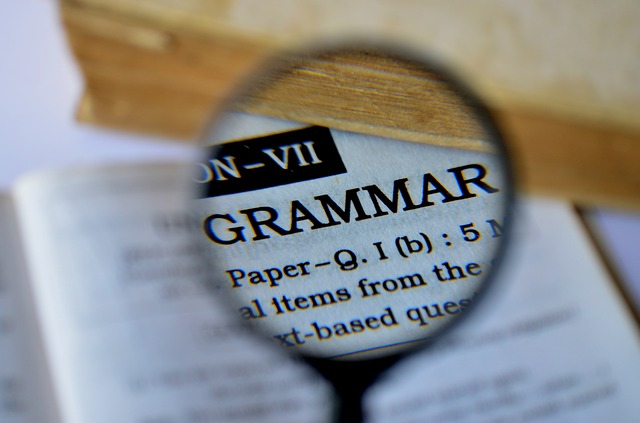Grammar Spotlight
 The English Grammar Profile (EGP) is a sister resource to the English Vocabulary Profile, and has been put together by Anne O'Keeffe (Limerick University) and Geraldine Mark, the co-authors, along with Ron Carter and Mike McCarthy, of English Grammar Today (Cambridge University Press). Mark and O'Keeffe investigated the extensive data in the Cambridge Learner Corpus to establish when learners begin to get to grips with different linguistic structures.
The English Grammar Profile (EGP) is a sister resource to the English Vocabulary Profile, and has been put together by Anne O'Keeffe (Limerick University) and Geraldine Mark, the co-authors, along with Ron Carter and Mike McCarthy, of English Grammar Today (Cambridge University Press). Mark and O'Keeffe investigated the extensive data in the Cambridge Learner Corpus to establish when learners begin to get to grips with different linguistic structures.
A series of insights from their research will be posted on this page, each one putting the spotlight on an interesting aspect of learner grammar development. Please note that all of the learner examples come from the Cambridge Learner Corpus, a 55-million word electronic collection of written learner data. The examination and the candidate’s first language are given in brackets after each learner example.
See the latest Grammar Spotlight entry below. Scroll right down to the bottom of this page to browse through previous entries.
At the B1 level, learners make great improvements in their use of should - some of which are unexpected. For example, should have + the past participle is generally taught at the B2 level, yet evidence suggests that learners are able to use this structure successfully at B1 to talk about regrets or undesirable situations in the past and to emphasise points in a story.
 You should have been there with me, I had a great time. (Cambridge English: Preliminary; Spanish - Latin American)
You should have been there with me, I had a great time. (Cambridge English: Preliminary; Spanish - Latin American)
 He had written that he was sorry and that he should not have done it. (Cambridge English: (Preliminary; French)
He had written that he was sorry and that he should not have done it. (Cambridge English: (Preliminary; French)
 You should have heard the noise. (CELSP; Spanish - Latin American)
You should have heard the noise. (CELSP; Spanish - Latin American)
Its negative form (shouldn’t have + the past participle), on the other hand, is used less frequently than the affirmative. However, when it does appear, it is used accurately, including among its uses the polite acceptance of a gift.
 Thank you for the money, you shouldn’t have sent it. (CELSP; Spanish - Latin American)
Thank you for the money, you shouldn’t have sent it. (CELSP; Spanish - Latin American)
 I have an appointment. I know I shouldn’t have taken it during school time but I had no other choice. (Cambridge English: Preliminary; French)
I have an appointment. I know I shouldn’t have taken it during school time but I had no other choice. (Cambridge English: Preliminary; French)
 Our employees should not have to commute to your premises. (Business English Certificate: Preliminary; Polish)
Our employees should not have to commute to your premises. (Business English Certificate: Preliminary; Polish)
Learners at the B1 level use the question tag form shouldn’t + a pronoun to make suggestions and ask for opinions.
 When you come back, we should rent some movies, shouldn’t we? (Cambridge English: Preliminary; Spanish - Latin American)
When you come back, we should rent some movies, shouldn’t we? (Cambridge English: Preliminary; Spanish - Latin American)
 I think I should write about the history of our company, shouldn’t I? (Business English Certificate: Preliminary; German)
I think I should write about the history of our company, shouldn’t I? (Business English Certificate: Preliminary; German)
 I think I should follow her advice, shouldn’t I? (Cambridge English: Preliminary; Italian)
I think I should follow her advice, shouldn’t I? (Cambridge English: Preliminary; Italian)
B1 learners also use should to talk about ideal or desired situations.
 British people should eat more vegetables and fruit and avoid fast food! (Cambridge English: Preliminary; Italian)
British people should eat more vegetables and fruit and avoid fast food! (Cambridge English: Preliminary; Italian)
 I think everyone should learn to cook, you never know when you need to cook. (Skills for Life: Entry 3; Panjabi)
I think everyone should learn to cook, you never know when you need to cook. (Skills for Life: Entry 3; Panjabi)
Learners can use should to talk about what is likely to happen.
 [talking about an event] It should be a good day! (Cambridge English: Preliminary for Schools; Russian)
[talking about an event] It should be a good day! (Cambridge English: Preliminary for Schools; Russian)
 …the weather is still warm, so we should be able to visit the beaches and go sightseeing in the evenings. (Cambridge English: Preliminary; Portuguese)
…the weather is still warm, so we should be able to visit the beaches and go sightseeing in the evenings. (Cambridge English: Preliminary; Portuguese)
Learners rapidly expand their understanding of the uses of should at the B1 level. Before the B2 level is achieved, the majority of uses of should are already known to learners. Yet, it remains that native speakers are using this common modal nearly twice as often as A2 and B1 learners. This gap closes significantly at the B2 level, when learners add to the contexts in which they use should.






